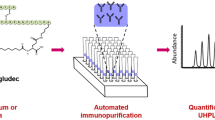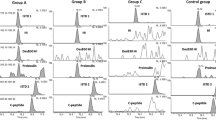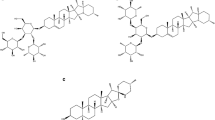Abstract
Diabetes is a worldwide disease in perpetual expansion. Type 1 and sometimes type 2 diabetic patients require daily human insulin (HI) or analog administration. Easy access to insulins for insulin-treated diabetics, their relatives, and medical professionals can enable abuse for suicidal or homicidal purpose. However, demonstrating insulin overdose in postmortem blood is challenging. Tissue analyses are contributive, as insulins can accumulate before death or undergo only limited degradation. The present study describes an assay for HI and synthetic analogs (lispro, aspart, glulisine, detemir and degludec, glargine and its main metabolite (M1)) in liver, kidney, muscle, and injection site samples. It is based on a 5-step sample preparation (reduction of tissue sample size, homogenization, extraction, concentration, and immunopurification) associated with liquid chromatography coupled to high-resolution mass spectrometry (LC–MS/HRMS). Selectivity and limit of detection (LOD) for all target analogs were assessed in the above matrices. LOD was determined at 25 ng/g for HI and for analogs except detemir and degludec, where LOD was 50 ng/g in kidney and injection site samples and 80 ng/g in the liver and muscle. The method was applied to13 forensic cases in which insulin use was suspected.


Similar content being viewed by others
References
Tokarz VL, MacDonald PE, Klip A (2018) The cell biology of systemic insulin function. J Cell Biol 217:2273–2289. https://doi.org/10.1083/jcb.201802095
Sirhan W, Piran R (2020) Current approaches in diabetes treatment and other strategies to reach normoglycemia. Curr Top Med Chem. https://doi.org/10.2174/1568026620666200716113813
Marks V (2009) Murder by insulin: suspected, purported and proven-a review. Drug Test Anal 1:162–176. https://doi.org/10.1002/dta.38
Bottinelli C, Cartiser N, Bevalot F, Fanton L, Guitton J (2020) Is insulin intoxication still the perfect crime? Analysis and interpretation of postmortem insulin: review and perspectives in forensic toxicology. Crit Rev Toxicol 50:324–347. https://doi.org/10.1080/10408444.2020.1762540
Hess C, Madea B, Daldrup T, Musshoff F (2013) Determination of hypoglycaemia induced by insulin or its synthetic analogues post mortem. Drug Test Anal 5:802–807. https://doi.org/10.1002/dta.1500
Wunder C, Kauert GF, Toennes SW (2014) Factors leading to the degradation/loss of insulin in postmortem blood samples. Forensic Sci Int 241:173–177. https://doi.org/10.1016/j.forsciint.2014.06.003
Ojanpera I, Sajantila A, Vinogradova L, Thomas A, Schanzer W, Thevis M (2013) Post-mortem vitreous humour as potential specimen for detection of insulin analogues by LC-MS/MS. Forensic Sci Int 233:328–332. https://doi.org/10.1016/j.forsciint.2013.10.009
Elgee NJ, Williams RH, Lee ND (1954) Distribution and degradation studies with insulin I131. J Clin Invest 33:1252–1260. https://doi.org/10.1172/JCI103000
Johansson E, Lubberink M, Heurling K, Eriksson JW, Skrtic S, Ahlstrom H, Kullberg J (2018) Whole-body imaging of tissue-specific insulin sensitivity and body composition by using an integrated PET/MR system: a feasibility study. Radiology 286:271–278. https://doi.org/10.1148/radiol.2017162949
Dickson SJ, Cairns ER, Blazey ND (1977) The isolation and quantitation of insulin in post-mortem specimens–a case report. Forensic Sci 9:37–42
Fletcher SM (1983) Insulin. A forensic primer. J Forensic Sci Soc 23:5–17
Lutz R, Pedal I, Wetzel C, Mattern R (1997) Insulin injection sites: morphology and immunohistochemistry. Forensic Sci Int 90:93–101
Palmiere C, Sabatasso S, Torrent C, Rey F, Werner D, Bardy D (2015) Post-mortem determination of insulin using chemiluminescence enzyme immunoassay: preliminary results. Drug Test Anal 7:797–803. https://doi.org/10.1002/dta.1775
Tong F, Wu R, Huang W, Yang Y, Zhang L, Zhang B, Chen X, Tang X, Zhou Y (2017) Forensic aspects of homicides by insulin overdose. Forensic Sci Int 278:9–15. https://doi.org/10.1016/j.forsciint.2017.06.015
Wehner F, Mittmeyer HJ, Wehner HD, Schieffer MC (1998) Insulin- or morphine-injection? Immunohistochemical contribution to the elucidation of a case. Forensic Sci Int 95:241–246. https://doi.org/10.1016/s0379-0738(98)00099-1
Fletcher SM, Richards L, Moffat AC (1979) The detection of fatal insulin poisoning by tissue analysis. Vet Hum Toxicol 21(Suppl):197–199
Parfitt C, Church D, Armston A, Couchman L, Evans C, Wark G, McDonald TJ (2015) Commercial insulin immunoassays fail to detect commonly prescribed insulin analogues. Clin Biochem 48:1354–1357. https://doi.org/10.1016/j.clinbiochem.2015.07.017
Sunderland N, Wong S, Lee CK (2016) Fatal insulin overdoses: case report and update on testing methodology. J Forensic Sci 61(Suppl 1):S281-284. https://doi.org/10.1111/1556-4029.12958
Thomas A, Thevis M (2019) Recent advances in the determination of insulins from biological fluids. Adv Clin Chem 93:115–167. https://doi.org/10.1016/bs.acc.2019.07.003
Bolli GB, Hahn AD, Schmidt R, Eisenblaetter T, Dahmen R, Heise T, Becker RH (2012) Plasma exposure to insulin glargine and its metabolites M1 and M2 after subcutaneous injection of therapeutic and supratherapeutic doses of glargine in subjects with type 1 diabetes. Diabetes Care 35:2626–2630. https://doi.org/10.2337/dc12-0270
Hachiya HL, Treves ST, Kahn CR, Sodoyez JC, Sodoyez-Goffaux F (1987) Altered insulin distribution and metabolism in type I diabetics assessed by [123I]insulin scanning. J Clin Endocrinol Metab 64:801–808. https://doi.org/10.1210/jcem-64-4-801
Duckworth WC, Bennett RG, Hamel FG (1998) Insulin degradation: progress and potential. Endocr Rev 19:608–624. https://doi.org/10.1210/edrv.19.5.0349
Watanabe M, Hayasaki H, Tamayama T, Shimada M (1998) Histologic distribution of insulin and glucagon receptors. Braz J Med Biol Res 31:243–256. https://doi.org/10.1590/s0100-879x1998000200008
Thompson CS, Sykes RM, Muddle J, Dashwood MR (1991) Distribution of 125I-labelled insulin-binding sites in peripheral tissues of the normal and diabetic rat: an autoradiographic study. J Endocrinol 128:85–89
Beastall GH, Gibson IH, Martin J (1995) Successful suicide by insulin injection in a non-diabetic. Med Sci Law 35:79–85. https://doi.org/10.1177/002580249503500116
Blackburn M (2013) Advances in the quantitation of therapeutic insulin analogues by LC-MS/MS. Bioanalysis 5:2933–2946. https://doi.org/10.4155/bio.13.257
Thomas A, Walpurgis K, Tretzel L, Brinkkotter P, Fichant E, Delahaut P, Schanzer W, Thevis M (2015) Expanded test method for peptides >2 kDa employing immunoaffinity purification and LC-HRMS/MS. Drug Test Anal 7:990–998. https://doi.org/10.1002/dta.1868
Judak P, Van Eenoo P, Deventer K (2018) Utilizing ELISA-plate based immunopurification and liquid chromatography-tandem mass spectrometry for the urinary detection of short- and long acting human insulin analogues. J Pharm Biomed Anal 153:76–81. https://doi.org/10.1016/j.jpba.2018.02.024
Bottinelli C, Nicoli R, Bevalot F, Cartiser N, Roger C, Chikh K, Kuuranne T, Fanton L, Guitton J (2021) Development and validation of a method for quantification of human insulin and its synthetic analogues in plasma and post-mortem sera by LC-MS/HRMS. Talanta 225:122047. https://doi.org/10.1016/j.talanta.2020.122047
Legg KM, Labay LM, Aiken SS, Logan BK (2019) Validation of a fully automated immunoaffinity workflow for the detection and quantification of insulin analogs by LC-MS-MS in postmortem vitreous humor. J Anal Toxicol 43:505–511. https://doi.org/10.1093/jat/bkz014
Kernbach-Wighton G, Puschel K (1998) On the phenomenology of lethal applications of insulin. Forensic Sci Int 93:61–73
Marks V, Richmond C (2007) Insulin murders-true life cases. Royal Society of Medicine Press, London
Heise T, Mathieu C (2017) Impact of the mode of protraction of basal insulin therapies on their pharmacokinetic and pharmacodynamic properties and resulting clinical outcomes. Diabetes Obes Metab 19:3–12. https://doi.org/10.1111/dom.12782
Farmer TD, Jenkins EC, O’Brien TP, McCoy GA, Havlik AE, Nass ER, Nicholson WE, Printz RL, Shiota M (2015) Comparison of the physiological relevance of systemic vs. portal insulin delivery to evaluate whole body glucose flux during an insulin clamp. Am J Physiol Endocrinol Metab 308:E206-222. https://doi.org/10.1152/ajpendo.00406.2014
Birkinshaw VJ, Gurd MR, Randall SS, Curry AS, Price DE, Wright PH (1958) Investigations in a case of murder by insulin poisoning. Br Med J 2:463–468
Bryant C, Spencer DB, Miller A, Bakaysa DL, McCune KS, Maple SR, Pekar AH, Brems DN (1993) Acid stabilization of insulin. Biochemistry 32:8075–8082
Acknowledgements
The authors gratefully acknowledge the staff from Medicolegal Institute of Lyon for their practical collaboration and their investment in this work and Iain McGill (freelance translator specializing in health and life sciences) for proofreading the article.
Author information
Authors and Affiliations
Corresponding author
Ethics declarations
Ethical approval
All procedures performed in studies involving human participants were in accordance with the 1964 Helsinki Declaration and its later amendments or comparable ethical standards. Samples were obtained from forensic autopsies and corresponded to a complete protocol of sample collection for forensic toxicological evidence. Toxicological results can be used anonymously for scientific purposes.
Conflict of interest
The authors declare no competing interests.
Additional information
Publisher's note
Springer Nature remains neutral with regard to jurisdictional claims in published maps and institutional affiliations.
Rights and permissions
About this article
Cite this article
Bottinelli, C., Bévalot, F., Cartiser, N. et al. Detection of insulins in postmortem tissues: an optimized workflow based on immunopurification and LC–MS/HRMS detection. Int J Legal Med 135, 1813–1822 (2021). https://doi.org/10.1007/s00414-021-02598-9
Received:
Accepted:
Published:
Issue Date:
DOI: https://doi.org/10.1007/s00414-021-02598-9




